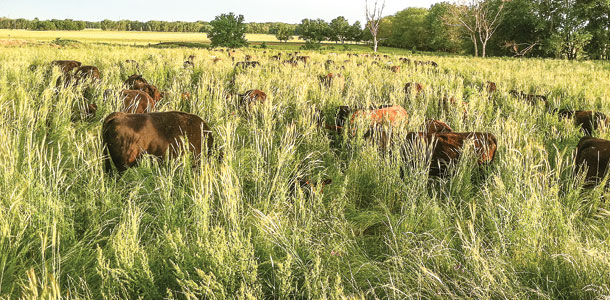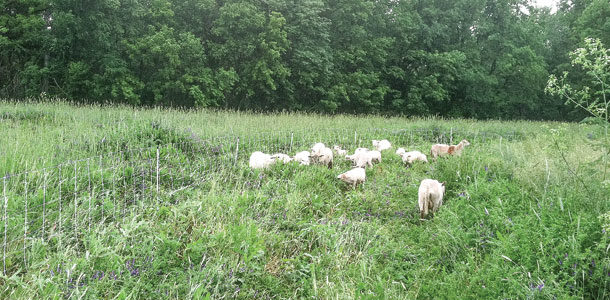Cover crops have traditionally been used to help hold the soil when transitioning between different types of cash crops and are often plowed under before planting the next crop to add organic material and fertility to the soil. Farmers with livestock often select cover crops that can be grazed, adding an additional benefit (feed for livestock) and the advantage of animal manure.
Shelby Filley, animal and range science extension specialist with Oregon State University, assists livestock graziers with pasture management and productivity.
“There are different objectives with different cover crops. A person might choose deep-rooted species that help improve aeration of the soil and pulling up more nutrients to the surface or crops that improve the tilth (soil condition) and decrease compaction,” Filley says.
“Grazing the cover crop can be beneficial in accelerating the breakdown of plant tissues to add more litter and manure to the soil. It speeds the whole process. Rather than turning it under and letting it rot, if you run it through the animal, it hastens the breakdown with all the microbes of the rumen,” she explains.
“Traditionally, I think of cover crops as a temporary crop so the soil won’t remain bare while it’s fallow. Then the cover crop can be incorporated into the soil by tillage the next season, before you plant another crop, or you can do some intercropping in rows with the cover crop.

For grazing, the nutritional value of cover crops is usually very high because they are generally in a vegetative (growing) phase when grazed. You just need to make sure the grazing doesn’t interfere with the purpose of the cover crop, and investigate its suitability for livestock – which types of plants would be good for grazing as well as for a cover crop,” says Filley.
“You want to make sure there are no harmful alkaloids, nitrates or other toxic properties or physical characteristics that might cause problems. A person also needs to consider things like bloat or possible choke. Phytoestrogens – substances that mimic the animals’ own estrogens – can be a problem with certain clovers as cover crops. It pays to investigate suitability for grazing,” she says.
To get the most benefit from some types of cover crop, it pays to strip graze, moving the animals across the field with portable electric fencing so they can use one portion of forage efficiently before moving into the next.
“In Oregon, we often use annual ryegrass as a cover crop. It grows so fast that it can often be grazed within six weeks of planting. One producer put annual ryegrass on a field he tilled as something to put on it quickly because he didn’t have time to finish working up the field for a permanent pasture seeding.
He was able to have sheep grazing on it six weeks after he planted it because it was so well-rooted by then. Conditions were perfect when he planted the seed. There was hard rain the night after he planted it, pounding the seed into the soil. Then the weather turned warm, and it popped right up and grew quickly,” says Filley.
“When people need a good cover crop for erosion control, I usually suggest annual ryegrass just because it does come up so fast and the seed is inexpensive.” Find something that will work well in your climate. If you are trying something new or exotic, it’s best to plant a small area at first (rather than planting the whole farm) to see how it does in your conditions.
“There are a number of good forage crops that can work for extending the summer grazing season – either early (before the typical pasture is ready for grazing) or late into fall and winter. If a person needs to renovate a field or change it over to something else, this is the perfect time to try a cover crop that you could graze to add extra forage to your grazing system,” she explains.
“One consideration if you plan to graze it is to make sure the crop is well-rooted so the animals won’t pull it up. Also be sure it is compatible with your goal for the cover crop and the type of livestock you plan to graze it with. If soils are fragile and there is risk for compaction, and you want to use it early in the year, it might be best used by lightweight cattle or with sheep or goats,” says Filley.
Kansas farmer Gail Fuller (near Emporia) experimented with no-till farming on and off during the 1980s. “Because of ignorance and foolish pride on my part – too proud to ask for advice – I failed most of the time. In the mid-1990s, I was frustrated and tired of erosion. I went completely no-till and the erosion didn’t get better – and in some places actually got worse. It wanted to blame the no-till methods but it was actually due to mismanagement,” says Fuller.
“I realized we did not change crop rotations enough. I’d tried to make our traditional rotation practices (which at that time was corn and soybeans) fit our no-till. Most of the corn was chopped for silage. We were following corn with soybeans, so there was no residue, no carbon added to the soil. The erosion just got worse,” he says.
Then he attended a conference called No-Till on the Plains, in the late 1990s. “They were talking about cover crops. I tried those a couple of years, but there was no one that I knew of doing it. Then we had a severe drought in 2000 and no income. The first thing that got cut was the cover crops,” he says.
“We not only went back to what we were doing earlier but also had to bale most of our soybeans that year to keep the bank happy. We stayed dry the next few years, and our yields slowly declined and erosion got worse again. That’s when it dawned on me that we’d actually been heading the right direction with cover crops. Instead of taking things out of rotation, we needed to be adding things into it,” says Fuller.
In 2003-2004, he went back to cover-cropping. “Only this time, instead of using a monoculture, we used mixes – trying to imitate Mother Nature. It didn’t take long, and when I started over the second time I started much smaller, with a few plots next to our feedlot. It didn’t take a rocket scientist to realize there was a lot of good, cheap forage here. We traded corn for some cows and started grazing those cover crops,” he says.
“I was scared to death because most of these things we were using as cover crops I’d never heard of, let alone feeding them to cattle, not knowing what it would do to the cow. But that’s how we got started. From there, it just exploded,” Fuller says.
“We started grazing those cover crops and went to more conferences and listened to people like Dave Morell, Gabe Brown, Neil Dennis, Ken Miller, Doug Peterson, Jim Gerrish and Greg Judy. They were using mob grazing and talking holistically, and this intrigued me.
I thought I was doing intensive rotational grazing because we were moving the cows every two to four weeks, but I soon realized I needed to speed it up. Now I move my cattle daily, sometimes up to eight times a day,” Fuller explains.
He followed the cover crops with two-way and three-way mixes and realized it wasn’t nearly enough. “Now most of our mixes are at least 15-way to 20-way. We are trying to imitate the native system, and for us it’s the tall grass prairie. We want as many plants as we have on the prairie – forbs, legumes and grasses.”
Fuller says agriculture in recent decades has moved too far away from a natural system, and people now have to re-learn the things that work. “With the exception of mob grazing, most of what we’re trying to learn today is what Grandpa or great-Grandpa did. They used cover crops to grow their legumes and to feed cattle,” says Fuller. FG
Heather Thomas Smith is a freelance writer based in Idaho.
PHOTOS
TOP PHOTO: Gail Fuller of Emporia, Kansas, grazes sheep on a cover-crop mix to prevent erosion.
BOTTOM PHOTO: Cattle intently graze a ryegrass cover-crop mix. Photos by Gail Fuller.










